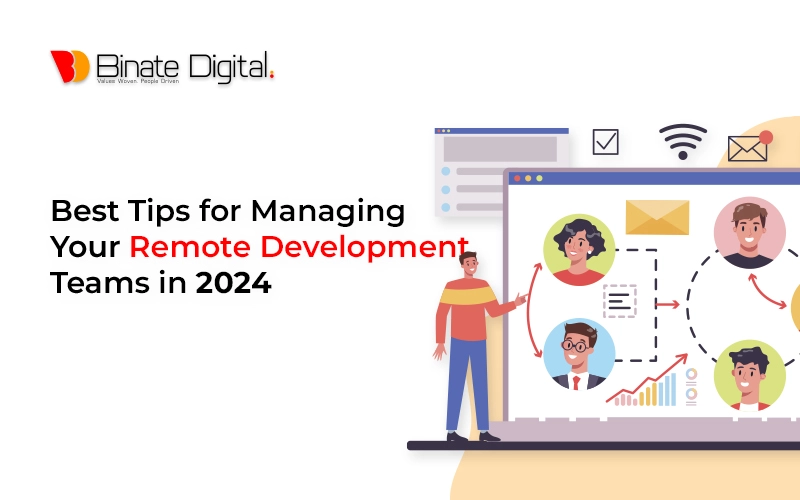All of us are well aware of the consequences that COVID-19 has brought into our lives. The pandemic caused disruption in almost all spheres of life. However, after a while, people started to realize the need to change their work patterns in order to continue their daily affairs. In such times, the working mode of companies and businesses also shifted from hiring in-house employees to hiring a remote development team, which has now become the new normal for some well-known companies.
In this blog, we will focus on reviewing some essential topics related to remote developmental teams. We will start off by discussing what a remote development team is, tips for managing such teams, and how to hire remote developers easily. So, without any further delay, let’s start with our topic.
On this Article
What is a Remote Developmental Team?
A remote development team is referred to as a collection of individuals with professional expertise and skills who collaborate to work on your project by carrying out developmental tasks from their own workplace. These teams work together to achieve the objectives of a project by effectively and efficiently developing products.
In this regard, people working in remote development teams are just as well-versed in working together as any in-house corporate team. They are called remote developers because these professionals work on the project from their own workplace, which may be spread out around the globe. You might be wondering how they can work in collaboration if there is no physical contact between the team members. A remote development team makes sure to connect with each other through on-site events or online meetings to keep communication flowing.
Why Hire a Remote Development Team For Your Company?
You might have heard the phrase “work smarter, not harder,” but have you ever thought about where this phrase applies in a practical way? Well, it certainly does in the case of remote development teams. Hiring such groups can be beneficial for both large-scale businesses and small-scale businesses, as it provides the following benefits:
- It saves time.
- It saves money.
- It allows for greater flexibility as well as the inclusion of a diverse population in your workspace.
- IT outsourcing for small businesses or large businesses allows them to get professional help.
- It helps in faster marketing and growth of the cause.
- Hiring a remote development team can add value to the productivity levels of employees.
What Are Some Tips That Would Help In Managing Remote Development Teams?
As much as it provides benefits, hiring a remote development team can be a bit challenging at times. Therefore, there are some tips that we will discuss that might help you understand how these teams work in collaboration with the company’s cause to work in an effective manner.
- Tip No. 1: Pay Special Attention To The Onboarding Process.
- Tip No. 2: Communication Is The Key.
- Tip No. 3: Maintaining A Proper Work Structure For Remote Teams.
- Tip No. 4: Utilizing Correct Software Tools.
- Tip No. 5: Having Solid Alternatives In Case Of Problems.
- Tip No. 6: Organize Events.
- Tip No. 7: Give Constant Feedback.
Tip No. 1: Pay Special Attention To The Onboarding Process
The first and foremost important tip to follow in IT outsourcing for small businesses or large businesses is to focus on the process of onboarding. In this regard, companies and businesses should give people with different backgrounds a chance to enter their workplace and benefit from their work culture.
Another point to focus on is communicating while hiring remote developers. In other words, business owners should try to deliver enough information regarding the project requirements, how the company works, what they are expecting, and additional essential information before locking the deal.
Both of these factors will help remote developers, as well as the organization, stay on the same page and have set rules and expectations from the first day.
Tip No. 2: Communication Is The Key
Communication is a factor that is not only crucial to hire remote developers, but it also plays a significant role throughout the project. In this regard, communication should be considered an ongoing process that must be followed by both parties in every phase of development.
Tech inventions can be risky and challenging. Such projects require constant alteration and upgrades. Therefore, a continuous flow of communication would result in mutual cooperation and collaboration.
Tip No. 3: Maintaining A Proper Work Structure For Remote Teams
The third tip for managing a remote development team is focused on maintaining a proper work structure and a hierarchy for remote teams. People often believe that to include remote development teams, they will have to transform the entire work structure of their organization. Although, this is not the case. In reality, companies and businesses can work just fine by keeping the same work structure and hierarchy for the remote teams as they do for their in-house working trams.
Obviously, there will be some level of difference between both working models, but it will be enough not to cause major disruptions or confusion. In this regard, organizations can keep the rule of reporting to appointed supervisors who will make sure that the remote development team is working at a proper pace and in an effective manner. Another strategy that can help is appointing a hierarchy for remote developers that will give team members clear instructions regarding whom to contact in what situations.
These guidelines help organizations keep a constant check on remote developers as well as not get bombarded by workload because of a proper hierarchy for remote employees.
Tip No. 4: Utilizing Correct Software Tools
The fourth tip for managing a remote development team is to explore and utilize the correct software tools developed to maintain proper work ethics between both parties. A common mistake committed by businesses and companies is that they often look out for a single software tool that will help them resolve all of their problems related to remote work patterns. However, in reality, there is not a single tool that can answer all your issues in one go.
In this regard, businesses and firms should focus on exploring the tools available in the market for different purposes and utilizing those that suit their purpose the best. Another factor that can help project owners get the most out of software tools is automating tasks that can be automated easily. Automation of tasks enables the team members to focus their attention on worthwhile projects rather than tedious ones.
A list of some of the beneficial software tools present in the market for remote development teams is mentioned in the list below, along with the purpose they serve.
- Trello and Jira for task tracking.
- Zoom and Google Meets for holding online meetings.
- CodeSandbox Live and CodePen for you to share codes easily.
- Podio and Redbooth for brainstorming ideas effectively.
- Relational database and Network database for managing databases efficiently.
Tip No. 5: Having Solid Alternatives In Case Of Problems
A common problem that is often faced by companies and businesses once they hire remote developers is the unavailability of a team member due to various reasons like falling ill, PC malfunctions, or other personal reasons and emergencies.
It is necessary for organizations to keep all these points in mind and devise practical solutions before opting for IT outsourcing for small businesses or developed firms. Once the process of risk assessment regarding different factors, including knowledge management, task assignment, geographical flexibility, cultural differences, technology/infrastructure setup, and others, is done, it becomes easier for project owners to come up with practical and effective backup strategies that will not negatively affect the project structure.
Tip No. 6: Organize Events
Next in line, we have another tip that is proven to work effectively in managing a remote development team. As we all know, instead of being a professional place, the workplace environment is also known to be enjoyable as it gives an opportunity to create a social circle and interact with others on a daily basis.
When we talk about remote development teams, these individuals do not get the chance to engage in such environments as they work independently. However, it is important for companies and businesses to organize events for such employees, which would help them interact with each other and engage in talks, except for work-related meetings.
You might be wondering how this is possible in situations where remote work team members work in different parts of the world. Well, thanks to technology, organizations can now make use of social networking platforms and other tools that allow them to organize online events for employees. In this way, colleagues can engage in lighthearted conversations, online games, informative sessions, and a lot more.
Tip No. 7: Give Constant Feedback
Last but not least, we have another beneficial suggestion or tip for people who hire remote developers for their projects. Instead of employees, be they in-house or remote workers, getting paid, another important factor that plays a huge role in their motivation is feedback. This feedback can be in the form of verbal appreciation or a small token of appreciation or reward. No matter what form of feedback you are opting for, it always boosts the confidence and morale of employees.
A similar thing goes with remote development team members. It is essential for project owners to provide an adequate amount of feedback and rewards at the correct time, just as they do with constructive criticism. This feedback creates a sense of connection and belongingness among the two parties, which is beneficial for the overall workplace environment.
What Are Some of the Models of Collaboration for Remote Development Teams?
After discussing some helpful tips that can be beneficial for managing a remote development team, we will move on to discussing some of the collaboration models that a business and company can opt for while hiring remote developers.
- Model No. 1: Dedicated Team Model
- Model No. 2: IT Staff Augmentation Model
- Model No. 3: Offshore Development Center Model
- Model No. 1: Dedicated Team Model
The first collaboration model that we will be discussing is known as the dedicated team model. In this strategy, businesses and companies may engage a whole remote development team rather than starting by setting up the entire system from scratch and hiring new team members for a specific project. With the help of remote developers, the whole software delivery process, including analysis, design, development, deployment, quality assurance, and support, is handled efficiently and professionally.
A dedicated team model is known to work well for lengthy projects with complex and frequently changing requirements. Remote workers specialized in their own fields make sure to deliver functional products by helping companies launch them on time without any errors.
- Model No. 2: IT Staff Augmentation Model
Next in line, we have the IT staff augmentation model of collaboration strategies. This model is a bit different from the dedicated team strategy as it requires hiring remote developers for a specific project requirement that needs to be completed, as you do not have enough resources or employees to carry out that task.
In this regard, the IT staff augmentation model is preferable for short-term projects as it allows remote developers to take up project responsibilities for a limited time. Once their work is done, they can move on to the next project available.
There are many benefits of the IT staff augmentation model, but we will discuss some of them in the below-mentioned points.
- IT staff augmentation models give you the chance to get proactive team members who successfully communicate and work to identify and provide the best solution.
- This model gives you a chance to stay on top of the market competition as proactive remote workers try their best to complete their tasks on time to get other projects.
- The greatest advantage of this model is that companies and businesses can get services at a reasonable cost and within a short amount of time.
- IT staff augmentation strategy is the best possible solution for small businesses, as it gives them access to a variety of skill sets as well as financial flexibility and cost adequacy.
- Model No. 3: Offshore Development Center Model
After IT staff augmentation, we have an offshore development center model that allows companies and businesses to set up an international business unit known as the offshore development center. This strategy helps to avoid managing several remote teams that are dispersed throughout the world by setting up a single developmental center that will deal with specific security needs, handle sensitive data, and manage sizable projects that rely on hardware.
How To Hire Remote Developers? A Complete Guideline
In the last section of our article, we will discuss the steps required to hire a remote development team.
- Step No. 1: Specify Job Requirements
- Step No. 2: Find Remote Developers
- Step No. 3: Screening The Candidates
- Step No. 4: Interviewing Candidates
- Step No. 5: Locking The Deal
- Step No. 6: Onboarding
- Step No. 1: Specify Job Requirements
The first step to hiring remote developers requires the project owner to identify the requirements they want in team members and create a proper and detailed job description to post on different platforms. A specific job requirement would include the following elements:
- Job title
- Suitable language
- Employment type
- Job location
- Work duration
- Job responsibilities
- Benefits
- Compensation
- Job qualifications
- Company overview, etc.
- Step No. 2: Find Remote Developers
After curating a detailed job description, project owners can move forward to the second step of hiring a remote development team that requires professional and skilled developers. This stage requires companies and businesses to post the job description on relevant platforms, including LinkedIn, etc.
- Step No. 3: Screening The Candidates
The third step of hiring a remote development team is known as the screening phase, in which a multi-step screening procedure is followed to evaluate the skills and work ethics of workers. Once you’ve narrowed down the list to the most deserving candidates, evaluate their qualifications to see if they’re a good fit for the job. This can be done with the help of the following procedures:
- With some support from your CTO or other in-house developers, you may begin with a technical or programming skills exam.
- You can also include questionnaires or surveys for screening candidates.
- After completing the exam to determine your level of programming ability, you can ask the developer for code samples, access to earlier projects, and other references to assist you in determining compatibility.
- Step No. 4: Interviewing Candidates
Once you have passed the screening phase, it is time to interview selected candidates to hire remote developers for your project. Just like the screening phase helps in assessing the technical skills of the candidate, the interviewing phase helps in assessing their soft skills. In simple words, an interview will help you learn more about the applicant to determine whether they are a good fit for your company’s principles and culture, as well as whether they can understand you well and reply straightforwardly.
- Step No. 5: Locking The Deal
Now that you are sure about the remote developer, it is time to lock the deal by discussing some essential elements, including the duration of the contract, the working mechanism of the organization, the salary package, etc. After that, a legally binding contract must be signed to validate the agreements made.
- Step No. 6: Onboarding
The last step of hiring a remote development team is known as the onboarding phase, in which the team members are informed about all the important deadlines, software tools to be used, and other essential points so that the developers can start working.
To Wrap Up: The Importance Of Remote Developmental Teams
Remote developmental teams are becoming a new thing for companies and businesses as they provide a lot of benefits to organizations and make them work in a better and more effective way. For this reason, it is high time to hire a remote development team of skilled and talented people who can help you resolve your problems related to IT outsourcing for small businesses or large businesses in a much easier way through their expertise.







